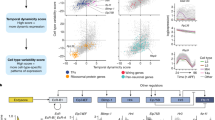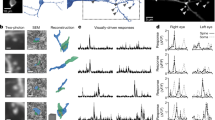Abstract
The segregation of axon and dendrite projections into distinct synaptic layers is a fundamental principle of nervous system organization and the structural basis for information processing in the brain1. Layer-specific recognition molecules that allow projecting neurons to stabilize transient contacts and initiate synaptogenesis2,3 have been identified. However, most of the neuronal cell-surface molecules critical for layer organization are expressed broadly in the developing nervous system4,5, raising the question of how these so-called permissive adhesion molecules support synaptic specificity. Here we show that the temporal expression dynamics of the zinc-finger protein sequoia is the major determinant of Drosophila photoreceptor connectivity into distinct synaptic layers. Neighbouring R8 and R7 photoreceptors show consecutive peaks of elevated sequoia expression, which correspond to their sequential target-layer innervation. Loss of sequoia in R7 leads to a projection switch into the R8 recipient layer, whereas a prolonged expression in R8 induces a redirection of their axons into the R7 layer. The sequoia-induced axon targeting is mediated through the ubiquitously expressed Cadherin-N cell adhesion molecule. Our data support a model in which recognition specificity during synaptic layer formation is generated through a temporally restricted axonal competence to respond to broadly expressed adhesion molecules. Because developing neurons innervating the same target area often project in a distinct, birth-order-dependent sequence, temporal identity seems to contain crucial information in generating not only cell type diversity during neuronal division6 but also connection diversity of projecting neurons.
This is a preview of subscription content, access via your institution
Access options
Subscribe to this journal
Receive 51 print issues and online access
$199.00 per year
only $3.90 per issue
Buy this article
- Purchase on Springer Link
- Instant access to full article PDF
Prices may be subject to local taxes which are calculated during checkout




Similar content being viewed by others
References
Sanes, J. R. & Yamagata, M. Formation of lamina-specific synaptic connections. Curr. Opin. Neurobiol. 9, 79–87 (1999)
Inoue, A. & Sanes, J. R. Lamina-specific connectivity in the brain: regulation by N-cadherin, neurotrophins, and glycoconjugates. Science 276, 1428–1431 (1997)
Yamagata, M., Weiner, J. A. & Sanes, J. R. Sidekicks: synaptic adhesion molecules that promote lamina-specific connectivity in the retina. Cell 110, 649–660 (2002)
Gil, O. D., Needleman, L. & Huntley, G. W. Developmental patterns of cadherin expression and localization in relation to compartmentalized thalamocortical terminations in rat barrel cortex. J. Comp. Neurol. 453, 372–388 (2002)
Lee, C. H., Herman, T., Clandinin, T. R., Lee, R. & Zipursky, S. L. N-cadherin regulates target specificity in the Drosophila visual system. Neuron 30, 437–450 (2001)
Isshiki, T., Pearson, B., Holbrook, S. & Doe, C. Q. Drosophila neuroblasts sequentially express transcription factors which specify the temporal identity of their neuronal progeny. Cell 106, 511–521 (2001)
Ting, C. Y. & Lee, C. H. Visual circuit development in Drosophila. Curr. Opin. Neurobiol. 17, 65–72 (2007)
Lee, T. & Luo, L. Mosaic analysis with a repressible cell marker for studies of gene function in neuronal morphogenesis. Neuron 22, 451–461 (1999)
Brenman, J. E., Gao, F. B., Jan, L. Y. & Jan, Y. N. Sequoia, a tramtrack-related zinc finger protein, functions as a pan-neural regulator for dendrite and axon morphogenesis in Drosophila. Dev. Cell 1, 667–677 (2001)
Ting, C. Y. et al. Drosophila N-cadherin functions in the first stage of the two-stage layer-selection process of R7 photoreceptor afferents. Development 132, 953–963 (2005)
Tomlinson, A. & Ready, D. F. Neuronal differentiation in Drosophila ommatidium. Dev. Biol. 120, 366–376 (1987)
Nern, A., Zhu, Y. & Zipursky, S. L. Local N-cadherin interactions mediate distinct steps in the targeting of lamina neurons. Neuron 58, 34–41 (2008)
Huang, Z. & Kunes, S. Hedgehog, transmitted along retinal axons, triggers neurogenesis in the developing visual centers of the Drosophila brain. Cell 86, 411–422 (1996)
Huang, Z., Shilo, B. Z. & Kunes, S. A retinal axon fascicle uses spitz, an EGF receptor ligand, to construct a synaptic cartridge in the brain of Drosophila. Cell 95, 693–703 (1998)
Bazigou, E. et al. Anterograde Jelly belly and Alk receptor tyrosine kinase signaling mediates retinal axon targeting in Drosophila. Cell 128, 961–975 (2007)
Shinza-Kameda, M., Takasu, E., Sakurai, K., Hayashi, S. & Nose, A. Regulation of layer-specific targeting by reciprocal expression of a cell adhesion molecule, capricious. Neuron 49, 205–213 (2006)
Zhu, S. et al. Gradients of the Drosophila Chinmo BTB-zinc finger protein govern neuronal temporal identity. Cell 127, 409–422 (2006)
Grosskortenhaus, R., Pearson, B. J., Marusich, A. & Doe, C. Q. Regulation of temporal identity transitions in Drosophila neuroblasts. Dev. Cell 8, 193–202 (2005)
Kay, J. N. et al. Transient requirement for ganglion cells during assembly of retinal synaptic layers. Development 131, 1331–1342 (2004)
Mumm, J. S. et al. In vivo imaging reveals dendritic targeting of laminated afferents by zebrafish retinal ganglion cells. Neuron 52, 609–621 (2006)
Chotard, C., Leung, W. & Salecker, I. glial cells missing and gcm2 cell autonomously regulate both glial and neuronal development in the visual system of Drosophila. Neuron 48, 237–251 (2005)
Tahayato, A. et al. Otd/Crx, a dual regulator for the specification of ommatidia subtypes in the Drosophila retina. Dev. Cell 5, 391–402 (2003)
Wernet, M. F. et al. Stochastic spineless expression creates the retinal mosaic for colour vision. Nature 440, 174–180 (2006)
Wernet, M. F. et al. Homothorax switches function of Drosophila photoreceptors from color to polarized light sensors. Cell 115, 267–279 (2003)
Blagburn, J. M., Alexopoulos, H., Davies, J. A. & Bacon, J. P. Null mutation in shaking-B eliminates electrical, but not chemical, synapses in the Drosophila giant fiber system: a structural study. J. Comp. Neurol. 404, 449–458 (1999)
Kaminker, J. S., Canon, J., Salecker, I. & Banerjee, U. Control of photoreceptor axon target choice by transcriptional repression of Runt. Nature Neurosci. 5, 746–750 (2002)
McGuire, S. E., Mao, Z. & Davis, R. L. Spatiotemporal gene expression targeting with the TARGET and gene-switch systems in Drosophila. Sci. STKE 2004, pl6 (2004)
Chang, H. C. et al. Hsc70 is required for endocytosis and clathrin function in Drosophila. J. Cell Biol. 159, 477–487 (2002)
Garrity, P. A. et al. Retinal axon target selection in Drosophila is regulated by a receptor protein tyrosine phosphatase. Neuron 22, 707–717 (1999)
Senti, K. A. et al. Flamingo regulates R8 axon–axon and axon–target interactions in the Drosophila visual system. Curr. Biol. 13, 828–832 (2003)
Banerjee, U., Renfranz, P. J., Pollock, J. A. & Benzer, S. Molecular characterization and expression of sevenless, a gene involved in neuronal pattern formation in the Drosophila eye. Cell 49, 281–291 (1987)
Iwai, Y. et al. Axon patterning requires DN-cadherin, a novel neuronal adhesion receptor, in the Drosophila embryonic CNS. Neuron 19, 77–89 (1997)
Fujita, S. C., Zipursky, S. L., Benzer, S., Ferrus, A. & Shotwell, S. L. Monoclonal antibodies against the Drosophila nervous system. Proc. Natl Acad. Sci. USA 79, 7929–7933 (1982)
O'Neill, E. M., Rebay, I., Tjian, R. & Rubin, G. M. The activities of two Ets-related transcription factors required for Drosophila eye development are modulated by the Ras/MAPK pathway. Cell 78, 137–147 (1994)
Campbell, G. et al. RK2, a glial-specific homeodomain protein required for embryonic nerve cord condensation and viability in Drosophila. Development 120, 2957–2966 (1994)
Nolo, R., Abbott, L. A. & Bellen, H. J. Senseless, a Zn finger transcription factor, is necessary and sufficient for sensory organ development in Drosophila. Cell 102, 349–362 (2000)
Kuhnlein, R. P. et al. spalt encodes an evolutionarily conserved zinc finger protein of novel structure which provides homeotic gene function in the head and tail region of the Drosophila embryo. EMBO J. 13, 168–179 (1994)
Sun, Q., Bahri, S., Schmid, A., Chia, W. & Zinn, K. Receptor tyrosine phosphatases regulate axon guidance across the midline of the Drosophila embryo. Development 127, 801–812 (2000)
Desai, C. J., Popova, E. & Zinn, K. A Drosophila receptor tyrosine phosphatase expressed in the embryonic CNS and larval optic lobes is a member of the set of proteins bearing the ‘HRP’ carbohydrate epitope. J. Neurosci. 14, 7272–7283 (1994)
Hortsch, M., Bieber, A. J., Patel, N. H. & Goodman, C. S. Differential splicing generates a nervous system-specific form of Drosophila neuroglian. Neuron 4, 697–709 (1990)
Usui, T. et al. Flamingo, a seven-pass transmembrane cadherin, regulates planar cell polarity under the control of Frizzled. Cell 98, 585–595 (1999)
Van Vactor, D. L., Cagan, R. L., Kramer, H. & Zipursky, S. L. Induction in the developing compound eye of Drosophila: multiple mechanisms restrict R7 induction to a single retinal precursor cell. Cell 67, 1145–1155 (1991)
Acknowledgements
We thank H. Bellen, J. Brenman, I. Salecker and R. Schuh for fly stocks and antibodies; D. Hawellek for the identification and analysis of seq6; and H. Aberle, S. Bogdan, C. Klämbt, A. Püschel and members of the Hummel laboratory for critical comments on the manuscript. T.H. is supported by the Deutsche Forschungsgemeinschaft (SFB629) and the EMBO Young Investigator Programme.
Author Contributions M.P. designed and performed all the experiments, and M.P. and T.H. wrote the manuscript.
Author information
Authors and Affiliations
Corresponding author
Supplementary information
Supplementary Information
This file contains Supplementary Figures S1-S12 with Legends (PDF 3952 kb)
Rights and permissions
About this article
Cite this article
Petrovic, M., Hummel, T. Temporal identity in axonal target layer recognition. Nature 456, 800–803 (2008). https://doi.org/10.1038/nature07407
Received:
Accepted:
Published:
Issue Date:
DOI: https://doi.org/10.1038/nature07407
This article is cited by
-
Spatio-temporal relays control layer identity of direction-selective neuron subtypes in Drosophila
Nature Communications (2018)
-
The intracellular redox protein MICAL-1 regulates the development of hippocampal mossy fibre connections
Nature Communications (2014)
-
Temporally matched subpopulations of selectively interconnected principal neurons in the hippocampus
Nature Neuroscience (2011)
-
Expression of classic cadherins and δ-protocadherins in the developing ferret retina
BMC Neuroscience (2009)
Comments
By submitting a comment you agree to abide by our Terms and Community Guidelines. If you find something abusive or that does not comply with our terms or guidelines please flag it as inappropriate.



